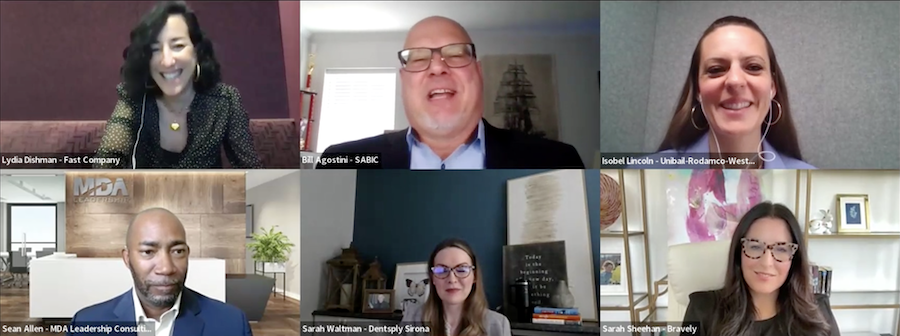Trust and Transformation: The Role of Coaching in Employee Development


Sarah Sheehan, founder and CEO of Bravely, says her most memorable coaching story involves a young woman of color who was having difficulty finding the confidence to ask her manager about getting a promotion or a raise.
“She had put in the work over time and had done multiple jobs,” Sheehan said during an executive panel discussion at From Day One’s May virtual conference. “This is a case where we were pretty sure on the coaching side that if she were to move forward and talk to her manager, that would propel her to a better place.”
The end result was “that she did, in fact, get a promotion, much to her surprise,” Sheehan told moderator Lydia Dishman of Fast Company. “This is a great example of the huge gap where we often give coaching to the people in more senior roles, when really everyone deserves coaching, from your first job to the C-level.”
Coaching is the most powerful resource a company can provide its employees because of its individualized nature, says Sheehan. Having a coach is somewhat like having “a work therapist, because what is impacting us in our personal life translates to our professional life and impacts how we show up at work.”
Building a Relationship Based on Trust
Any coaching relationship must be based on trust. The employee “has to believe you’re there for them and working with them, and really understanding what will be shared or not shared,” said William Agostini, senior advisor, strategic HR at SABIC.
The employee also has to have faith that the coach “understands the realities of where they are,” Agostini said. Additionally, “coaches should not be projecting their own culture onto someone else. There are realities of different cultures and situations.”
However, coaches also need to see and hear employees as individuals, versus whatever gender, age, or cultural label you might want to put on them, says Agostini. In addition, he recommends giving employees “the opportunity to give you feedback about your assumptions.”
Building an atmosphere of trust pays dividends in terms of employee retention, says Isobel Lincoln, SVP of HR for Unibail-Rodamco-Westfield. Over the past two and a half years, every team member who received executive coaching is still there.
“They come into it feeling like, ‘Wow, this is something really for me. I can transform personally and professionally,’” Lincoln said.

Support from key stakeholders, including management, ensures that the employee receiving the coaching is getting feedback “which means that they're also helping to rewrite the script in whatever way they need to, whether it's just elevating and building confidence as a leader or changing some of those behaviors,” Lincoln said.
Determining Who to Coach
Sean Allen, a SVP of strategy & talent solutions, at MDA Leadership Consulting, says he’s been asked to coach employees whose performance issues are so severe that they triggered an HR investigation. “That’s not what I would consider a good application of coaching,” he said.
Coaching works best when it is designed to be more aspirational, says Allen. The goal should be to “create role models in change, and change champions,” he said. “But beyond that, from a macro perspective, one thing I know we really rely on is broad and objective assessment based on formalized high potential models. That’s important because objectivity talks to fairness in a way that washes out bias as much as you can, and gives everybody a fair chance.”
This approach ensures companies invest in a diverse group of employees, says Allen. He said it also helps determine “who has what kind of ceiling and what kind of potential.”
The Role of Mentors and Sponsors
Mentors and sponsors also have a crucial part to play in helping employees advance in their careers.
Sarah Waltman, VP of global talent management and organizational development at Dentsply Sirona says that while coaches assist individuals along their journey, mentoring involves sharing your experiences with mentees. Sponsoring “is really about opening up some doors or finding some access to experiences that they wouldn’t otherwise have,” she said.
Coaching, mentoring, and sponsorship can all take place simultaneously. However, an employee might switch lanes, such as going from coaching into mentoring for a little bit, and then returning for more coaching or entering into a sponsorship, says Waltman.
Allen says that coaching, mentoring and sponsoring “can and should coexist in a complementary fashion to form a powerful ecosystem of development support.”
“For example, as a standard practice we leverage something called the growth network inside of a coaching engagement,” he said. “That brings into play sponsors, mentors, people who are in real business situations with the leader and can give them feedback. So it’s not coaching in a vacuum.”
Coaching Remote Employees
Even though pandemic restrictions have ended, working from home has not for some coaches and the employees they work with.
“For me, it’s actually been amazing to have the coaching contacts because even though I'm not in person with a lot of my peers and hires, having some of those coaching engagements has allowed me to get to know them,” Waltman said.
But remote work also presents certain challenges for employees when they try to show how they have grown as a result of coaching, says Lincoln.
“How can you support them to think through proactive ways for them to demonstrate this new mindset, this new leadership capability, and strategic thinking?” she said. “I think strong ownership and promotional campaigning in an authentic, positive way is something to be extra mindful of, because it’s going to take them extra time and effort to be able to showcase that change they’ve undergone.”
Mary Pieper is a freelance writer based in Mason City, Iowa.
The From Day One Newsletter is a monthly roundup of articles, features, and editorials on innovative ways for companies to forge stronger relationships with their employees, customers, and communities.